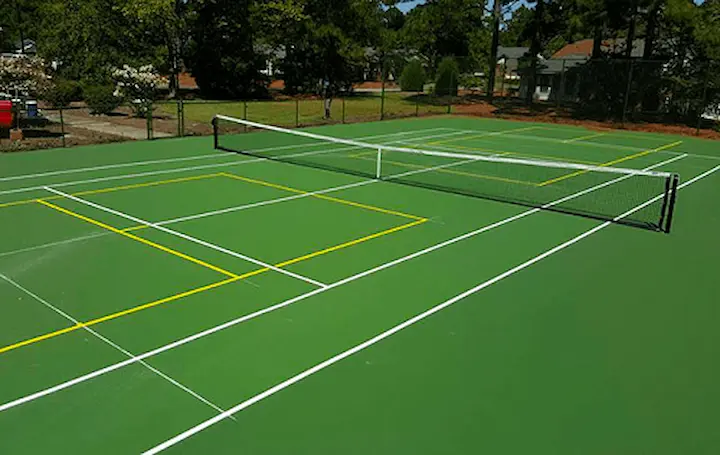Trick Factors in the Building And Construction of Pickleball Courts: From Site Selection to Last Surfaces
The building of pickleball courts incorporates an array of crucial aspects, starting with the option of an appropriate site that balances ease of access with ecological factors to consider. Crucial elements such as court dimensions, surface materials, and drain systems dramatically influence not just the top quality of play yet additionally the longevity of the facility.
Site Selection Criteria
When starting the construction of pickleball courts, it is important to nail down the site selection criteria that will ensure optimal playability and ease of access. The location must be easily reachable for gamers, preferably positioned near property locations or neighborhood centers, to encourage participation.
In addition, the surface must be degree and steady, as unequal ground can result in safety hazards and influence gameplay. Ample drain is likewise crucial; selecting a website with great water overflow will aid preserve court conditions during damaging weather condition.
One more important consideration is the availability of energies. Accessibility to electrical energy and water is needed for illumination and maintenance objectives. In addition, closeness to vehicle parking centers is necessary, helping with very easy accessibility for players and viewers alike.
Ecological factors can not be ignored; natural color from trees can enhance gamer comfort, while direct exposure to prevailing winds might disrupt play. Last but not least, zoning policies and area support need to be thought about to ensure that the job aligns with regional standards and gets the support it needs for successful execution. By thoroughly reviewing these criteria, stakeholders can produce a welcoming and useful environment for pickleball lovers.
Court Capacities and Format
To guarantee ideal gameplay and adherence to laws, the measurements and layout of pickleball courts should be very carefully specified. A basic pickleball court determines 20 feet in size and 44 feet in size for both songs and increases play. The recommended design includes a non-volley area, generally described as the "kitchen," extending 7 feet from the net on either side. This area is important, as it affects gamer positioning and shot option - Illinois and midwest.
The net height is set at 36 inches at the sidelines and 34 inches at the center, creating a slight dip that impacts sphere trajectory. Court markings are similarly essential; lines ought to be 2 inches broad and distinct in color to ensure presence.
In addition, a barrier area surrounding the court is recommended, generally extending 5 to 10 feet past the sidelines and standards to fit players' movements and enhance safety and security. Appropriate design and dimensions not just make certain conformity with official regulations yet additionally improve the overall having fun experience, suiting both leisure and competitive play. Mindful preparation in these areas is paramount to the effective building of pickleball courts.
Surface Product Options
Choosing the right surface area material for pickleball courts is crucial for making certain ideal player efficiency and safety. The selection of surface can considerably influence gameplay, including ball bounce, grip, and player convenience.
There are numerous options available, each with its distinctive qualities. Asphalt is a prominent selection as a result of its resilience and reduced maintenance requirements. It supplies a strong having fun surface area that can withstand numerous weather problems but might call for regular resurfacing.
Concrete is another commonly made use of material, supplying outstanding long life and a smooth finish. It enables for regular ball bounce however can be tough on players' joints, making it much less desirable for long-lasting play without correct padding.
For those seeking improved convenience and shock absorption, supported acrylic surfaces provide a sensible alternative. These surfaces integrate a base layer with an acrylic overcoat, providing improved traction and a softer feeling, which is beneficial for decreasing the threat of injuries.
Last but not least, synthetic turf is acquiring grip, specifically for multi-purpose centers. Its versatility and lower maintenance needs make it an appealing alternative, though it might not give the same ball reaction as standard difficult courts. Mindful factor to consider of these alternatives will certainly ensure an optimal playing environment.
Drainage and Lighting Considerations
Proper drainage and reliable illumination are vital components in the building and construction of pickleball courts, substantially influencing both playability and safety. Ample drain systems stop water accumulation, which can lead to unsafe surfaces useful link and damage to the court framework.
Illumination is equally vital, specifically for courts intended for night usage. Appropriate lighting enhances exposure, ensuring that players can see the round plainly and decreasing the risk of accidents. The placement of illumination components need to be strategically prepared to remove shadows and provide even circulation of light throughout the court. LED lights are suggested for their power performance and durability, supplying bright illumination while minimizing functional costs.

Final Surfaces and Maintenance
After dealing with drainage and lights factors to consider, interest turns to the final coatings and continuous maintenance of click to find out more pickleball courts. Common alternatives consist of acrylic finishes and specialized sports surfaces that give ideal traction and padding.

Seasonal maintenance could include resurfacing every few years, relying on usage and ecological variables. Correctly keeping nets, court lines, and surrounding locations is equally crucial to give a safe and satisfying having fun experience. By investing in high quality coatings and adhering to a structured upkeep timetable, facility owners can guarantee their pickleball courts continue to be in excellent condition for several years ahead.
Conclusion
To conclude, the effective construction of pickleball courts rests on precise interest to numerous crucial elements. Site choice must focus on accessibility and terrain security, while court measurements and layout must follow optimal requirements for gameplay. The selection of surface area product significantly influences player safety and performance. Additionally, efficient drain and appropriate lights add to court long life and presence. High quality finishes and a robust upkeep routine are necessary for protecting the court's condition, enhancing the total experience for gamers and spectators alike.